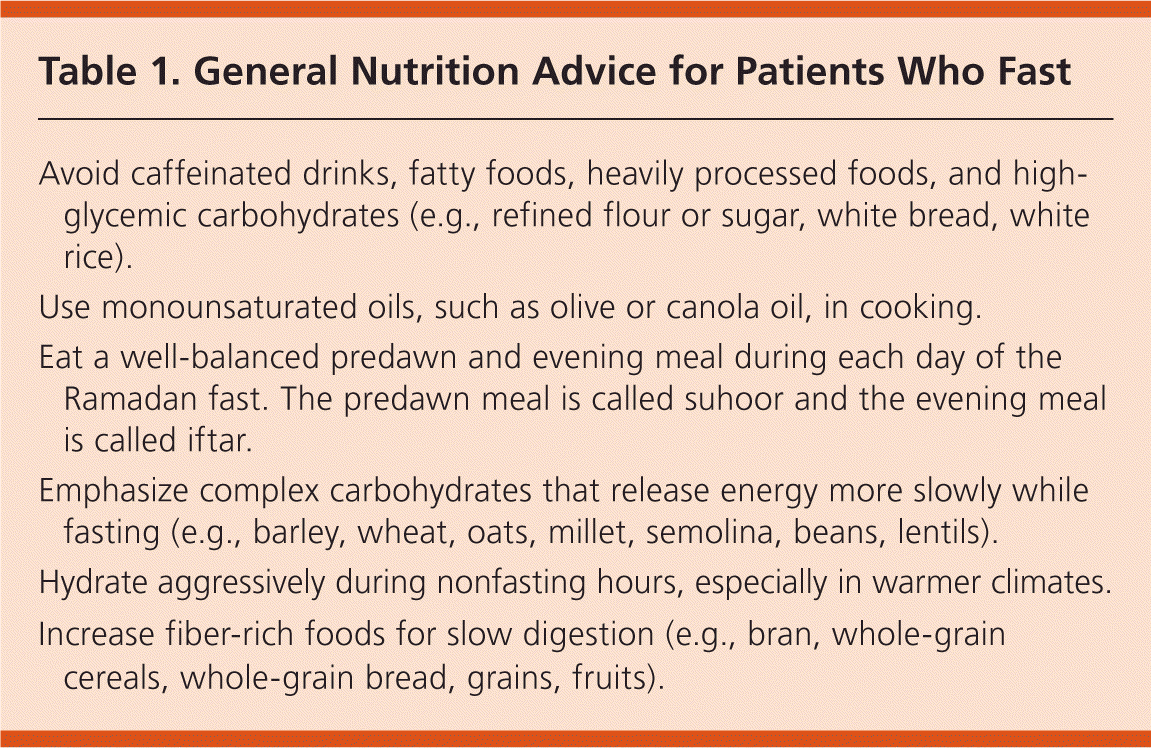
Am Fam Physician. 2015;91(9):640-642
Author disclosure: No relevant financial affiliations.
Case Scenario
A 68-year-old Muslim man who was recently diagnosed with type 2 diabetes mellitus presented for a routine health visit. His initial A1C level was 8.2%, which decreased to 6.7% after dietary changes, exercise, and treatment with metformin (Glucophage). He stated that he wanted to fast during Ramadan and requested advice on how to manage his diabetes while fasting. Because our clinic serves a large Muslim community, we have been seeking more general guidelines for advising vulnerable individuals and patients with medical conditions on a safe approach to fasting. What recommendations should we make to patients to maintain health while fasting during Ramadan?
Commentary
Ramadan is a holy month during which Muslims fast from eating, drinking, sexual intercourse, smoking, and all vices from dawn until sunset.1,2 The fast of Ramadan is one of the five pillars of Islam. It is an obligation for all healthy adult Muslims, with a focus on spiritual and physical well-being to strengthen one's relationship with God. Because it is based on a lunar calendar, the dates of Ramadan vary each year. In 2015, Ramadan is expected to occur from June 18 to July 17.
VULNERABLE GROUPS WHO OBSERVE FASTING
The Quran exempts the sick from fasting.1,2 According to Islamic scholars, persons exempt from fasting include individuals with illnesses that might be exacerbated by fasting (e.g., diabetes), women who are pregnant or breastfeeding, prepubertal children and adolescents, and those on medication regimens that would be affected by fasting. Other groups exempted from fasting include those with disabling mental illness or developmental disabilities, menstruating women, women with postpartum bleeding, older persons, and travelers.
Many Muslims who are exempt from fasting nonetheless choose to fast. Clinicians should be able to provide advice on how such patients should safely approach the fast.
DIABETES
Worldwide, an estimated 40 to 50 million patients with diabetes fast during Ramadan, including nearly one-half of those with type 1 diabetes and most of those with type 2 diabetes.1,3 Patients with diabetes who choose to fast require close blood glucose monitoring because there is an estimated 7.5-fold increase in severe hypoglycemia for those with type 2 diabetes.3 Other risks of fasting with diabetes, particularly when medications are withheld, include hyperglycemia, diabetic ketoacidosis, hyperosmolar hyperglycemic state, dehydration, and deep venous thrombosis.1,4 Clinicians should explain warning signs for these conditions to patients and instruct them to break the fast and seek medical attention if symptoms occur.
Specific recommendations in the literature provide risk stratification criteria to determine whether fasting is safe for patients with diabetes.1,4 Fasting is unsafe for patients with type 1 diabetes, but is generally considered safe for patients with well-controlled type 2 diabetes treated with oral agents. To avoid hypoglycemia, certain medications require dose adjustment. Metformin should be dosed twice daily with one-third of the total daily dose taken at the predawn meal and two-thirds at the larger evening meal.1,4 For sulfonylureas dosed twice daily, halving the predawn dose should be considered.1,4 Any oral agents dosed once daily should be taken at the evening meal. Thiazolidinediones, dipeptidyl-peptidase-4 inhibitors, and short-acting oral insulin secretagogues do not require adjustment because of the low risk of hypoglycemia. Patients with type 2 diabetes who are taking long-acting insulin and choose to fast should decrease each dose by 20%.4
In this case scenario, the patient has well-controlled diabetes on metformin monotherapy. He is in a low-risk category and can safely fast with careful blood glucose monitoring and dosing adjustment as described earlier.
PREGNANCY AND BREASTFEEDING
Islamic law exempts women who are pregnant or breastfeeding from fasting, and physicians should recommend against fasting for these patients. Nonetheless, many pregnant and breastfeeding women choose to fast during Ramadan.5,6 Women who do so should be advised to hydrate and consume nutritious foods during the predawn and evening meals. Clinicians should also give precautions against excessive daytime activity, and explain the warning signs that warrant breaking the fast, such as decreased fetal movement, extreme fatigue or dizziness, or nausea with vomiting.
CHILDREN AND ADOLESCENTS
The requirement to fast begins with puberty, so children are exempt from fasting. However, children often fast with their families for a portion of the day. Postpubertal adolescents generally fast, and those who are unaccustomed to fasting and participate in athletics or spend time outdoors in warm climates require special attention to avoid dehydration. Clinicians can help prevent dehydration by excusing students from physical education classes and advising student athletes to train in the early evening hours, just before or after breaking their fast.
MEDICATIONS
Consuming oral medications during the fasting hours invalidates the fast, and patients often skip midday doses. Therefore, long-acting forms of medications or twice-daily dosing regimens are options during Ramadan.2
Intramuscular and subcutaneous injections, eye and ear drops, and routine blood draws do not invalidate the fast. Donating blood is prohibited while fasting. Inhaled nebulizers and nasal sprays are generally allowed as long as the solution does not drain to the back of the throat.2 When in doubt about these or other issues, patients should be advised to consult their local religious leader. Table 1 lists general nutrition recommendations that clinicians can give to patients who are fasting.

| Avoid caffeinated drinks, fatty foods, heavily processed foods, and highglycemic carbohydrates (e.g., refined flour or sugar, white bread, white rice). |
| Use monounsaturated oils, such as olive or canola oil, in cooking. |
| Eat a well-balanced predawn and evening meal during each day of the Ramadan fast. The predawn meal is called suhoor and the evening meal is called iftar. |
| Emphasize complex carbohydrates that release energy more slowly while fasting (e.g., barley, wheat, oats, millet, semolina, beans, lentils). |
| Hydrate aggressively during nonfasting hours, especially in warmer climates. |
| Increase fiber-rich foods for slow digestion (e.g., bran, whole-grain cereals, whole-grain bread, grains, fruits). |
